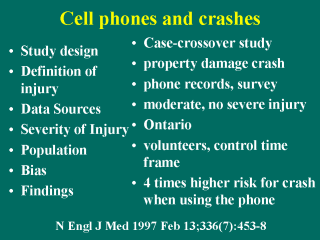| front |1 |2 |3 |4 |5 |6 |7 |8 |9 |10 |11 |12 |13 |14 |15 |16 |17 |18 |19 |20 |21 |22 |23 |24 |25 |26 | 27|28 |29 |30 |31 |32 |33 |34 |35 |36 |37 |38 |39 |40 |41 |42 |43 |44 |45 |46 |47 |48 |49 |50 |51 |review |
 |
Are you distracted
when using a cellular telephone in a car to the extent that you crash more
often? That is the basic question that this study seeks to address. This
work was one of the first examples of the case-crossover study design in the
injury literature. It examined a population of drivers in Toronto who
brought their vehicles into a collision damage assessment center following a
crash. They obtained informed consent from the drivers and got copies of
their phone records. The cases served as their own controls. Case events
included phone use at the time of the crash. Control events included phone
use at the same time on the day before the crash. Alternative evaluation
days were also considered. The data examines moderate crashes producing
property damage to the cars. No serious of fatal injury crashes are included. The authors found a higher risk for crash (4 times higher) at the time of phone use. This was a fairly well done study for its time. The study subjects, though, were all volunteers and may not be representative. The driving patterns in the control period may also have been different than in the case period. Source: Redelmeier DA, Tibshirani RJ. Association between cellular telephone calls and motor vehicle collisions. NEJM 336:453-458, 1997. |